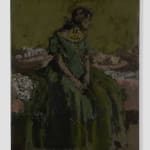Walter Richard Sickert 1860-1942
Regrets, c1904-5
oil on paper laid on panel
22 1/8 x 18 1/8 inches
56 x 46 cm
56 x 46 cm
signed
The intimate interiors with figures for which Walter Sickert is best known were introduced into his vocabulary on a long visit to Venice over the winter of 1903-04. He was...
The intimate interiors with figures for which Walter Sickert is best known were introduced into his vocabulary on a long visit to Venice over the winter of 1903-04. He was already in his early forties. After five years devoted almost exclusively to painting the streetscapes of Dieppe (where he had lived since 1898) and views of Venice (on visits of 1900 and 1901), he stayed indoors to draw and paint the local prostitutes that served as his models. He presented them clothed, nude, alone, together, awake, asleep, in conversation or contemplation. His output was prodigious. Figures in interiors remained his chief preoccupation on his return to France in 1904 and, ultimately, to London from 1905 onwards.
Brushwork, palette and compositional structure indicate that Regrets was painted between 1904-1906; it was first exhibited in Paris in January 1907. There are no circumstantial clues to establish whether it was painted in Venice, Dieppe, London or Paris. Because it is painted in oil on paper laid on panel, canvas size (English or continental) is no guide. The bed head, so often an indication of where a particular Sickert interior was painted, is outside the frame. The clothed figure is not one of Sickert’s many recognisable models. When I first published this painting in 2006, I had seen only a black and white photograph of it and thought the support was canvas. Having studied it now, I believe the location of the interior is most probably Paris, where Sickert lived and worked during the autumn of 1906, painting intimate interiors by day and music halls by night. The palette, dominated by greens (ranging from emerald to olive) relieved with ochres, salmon pinks, greys and jet black, and the variety of brushwork with broad sweeping strokes interspersed with lighter, lively areas of small, discrete dabs of paint, as well as the short hatched russet-coloured strokes on the arms, all accord with this suggestion. It is a delicious piece of painting.
The subject, in common with most of Sickert’s two-figure compositions, is ambiguous. What is the relationship between the two figures, one nude, prone and scarcely visible in the background, the other clothed and pensive? The mood is tender and meditative, but to what does the title refer? Sickert’s interiors were not illustrative. Sometimes the titles of his paintings suggest particular narratives, but his habit of changing the titles to subvert the thrust of that narrative was a deliberate challenge. Dawn, Camden Town and Summer in Naples are alternative titles for a single painting. Moreover, the original titles of many of his paintings are lost; others are spurious inventions of dealers and curators. Unusually, Regrets is both the only and the original title of this work.
©Wendy Baron
Brushwork, palette and compositional structure indicate that Regrets was painted between 1904-1906; it was first exhibited in Paris in January 1907. There are no circumstantial clues to establish whether it was painted in Venice, Dieppe, London or Paris. Because it is painted in oil on paper laid on panel, canvas size (English or continental) is no guide. The bed head, so often an indication of where a particular Sickert interior was painted, is outside the frame. The clothed figure is not one of Sickert’s many recognisable models. When I first published this painting in 2006, I had seen only a black and white photograph of it and thought the support was canvas. Having studied it now, I believe the location of the interior is most probably Paris, where Sickert lived and worked during the autumn of 1906, painting intimate interiors by day and music halls by night. The palette, dominated by greens (ranging from emerald to olive) relieved with ochres, salmon pinks, greys and jet black, and the variety of brushwork with broad sweeping strokes interspersed with lighter, lively areas of small, discrete dabs of paint, as well as the short hatched russet-coloured strokes on the arms, all accord with this suggestion. It is a delicious piece of painting.
The subject, in common with most of Sickert’s two-figure compositions, is ambiguous. What is the relationship between the two figures, one nude, prone and scarcely visible in the background, the other clothed and pensive? The mood is tender and meditative, but to what does the title refer? Sickert’s interiors were not illustrative. Sometimes the titles of his paintings suggest particular narratives, but his habit of changing the titles to subvert the thrust of that narrative was a deliberate challenge. Dawn, Camden Town and Summer in Naples are alternative titles for a single painting. Moreover, the original titles of many of his paintings are lost; others are spurious inventions of dealers and curators. Unusually, Regrets is both the only and the original title of this work.
©Wendy Baron
Provenance
Bernheim Jeune Gallery, ParisJohn Caftanzoglou, acquired at Hôtel Drouot
Mary Averoff, by descent from the above
Exhibitions
Paris, Bernheim Jeune, Exposition: Sickert, 10 - 19 January 1907, cat no.76Paris, Bernheim Jeune, Vente de 84 œuvres de Walter Sickert, 18 - 19 June 1909, cat no.30
Paris, Hôtel Drouot, 20 June 1909, with the sale on 21 June 1909
Literature
Adolphe Tavernier, Vente de 84 œuvres de Walter Sickert, Bernheim Jeune, Paris, 1909Wendy Baron, Sickert: Paintings and Drawings, Yale University Press, New Haven and London, 2006, p302, illus b/w fig.230
Join our mailing list
* denotes required fields
We will process the personal data you have supplied to communicate with you in accordance with our Privacy Policy. You can unsubscribe or change your preferences at any time by clicking the link in our emails.



